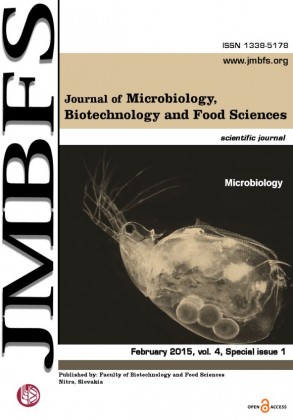ENDOGENAL COLONIZATION OF GRAPES BERRIES
DOI:
https://doi.org/10.15414/jmbfs.2015.4.special1.69-73Keywords:
Grapes, endogenal colonization, ochratoxin A, mycotoxinsAbstract
The aim of study was to detect the microscopic filamentous fungi from wine surface of sterilized grapes berries of Slovak origin. We analyzed 21 samples of grapes, harvested in the year 2012 of various wine-growing regions. For the isolation of species we used the method of direct plating surface-sterilized berries (using 0.4% freshly pre-pared chlorine) on DRBC (Dichloran Rose Bengal Chloramphenicol agar). The cultivation was carried at 25±1°C, for 5 to 7 days. A total number of 2541 fungal isolates pertaining to 18 genera including Mycelia sterilia were recovered. Isolates of genus Alternaria were found in all of tested samples with the highest relative density 56.4%. The second highest isolation frequency we detected for genus Fusarium (90.48% positive samples), but with low relative density (31 isolates and 2.99% RD). Another genera with higher isolation frequency were Cladosporium (Fr 85.71%, RD 14.6%), Mycelia sterilia (Fr 85.71%, RD 4.25%), Penicillium (Fr 80.95%, RD 13.42%), Botrytis (Fr 71.43%, RD 2.95%) Rhizopus (Fr 66.66%, RD 1.34%), Aspergillus (Fr 57.14%, RD 0.87%), Epicoccum (Fr 47.62%, RD 1.22%), Trichoderma (Fr 42.86%, RD 1.26%). Isolation frequency of another eight genera (Arthrinium, Dichotomophtora, Geotrichum, Harzia, Chaetomium, Mucor, Nigrospora and Phoma) was less than 10% and relative density less than 0.5%. Chosen isolates of potential producers of mycotoxin (species of Alternaria, Aspergillus, Fusarium and Penicillium) were tested for the ability to produce relevant mycotoxins in in vitro conditions using TLC method. None isolate of Aspergillus niger aggregate (13 tested) did not produce ochratoxin A – mycotoxin monitored in wine and another products from grapes berries. Isolates of potentially toxigenic species recovered from the samples were found to produce another mycotoxins: aflatoxin B1, altenuene, alternariol, alternariol monomethylether, citrinin, diacetoxyscirpenol, deoxynivalenol, HT-2 patulin, penitrem A and T-2 toxin in in vitro conditions. In conclusion, another research should be performed to detect the occurrence of these mycotoxins in grapes, must, wine and another products from grape.Downloads
Download data is not yet available.
Downloads
Published
2015-02-02
How to Cite
TanÄinová, D., Rybárik, ĽubomÃÂr, MaÅ¡ková, Z., Felšöciová, S., & CÃsarová, M. (2015). ENDOGENAL COLONIZATION OF GRAPES BERRIES. Journal of Microbiology, Biotechnology and Food Sciences, 4(special issue 1 (Microbiology), 69–73. https://doi.org/10.15414/jmbfs.2015.4.special1.69-73
Issue
Section
Microbiology
License
Copyright (c) 2015 Dana TanÄinová, ĽubomÃÂr Rybárik, Zuzana MaÅ¡ková, Soňa Felšöciová, Miroslava CÃsarová

This work is licensed under a Creative Commons Attribution 4.0 International License.
All papers published in the Journal of Microbiology, Biotechnology and Food Sciences are published under a CC-BY licence (CC-BY 4.0). Published materials can be shared (copy and redistribute the material in any medium or format) and adapted (remix, transform, and build upon the material for any purpose, even commercially) with specifying the author(s).





